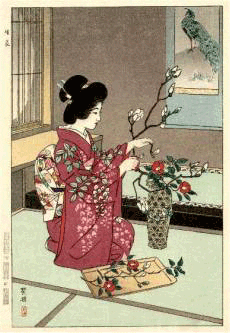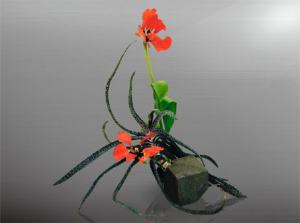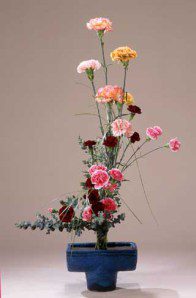Living Flowers of Ikebana: Richness of Culture in Japan
Sarah Deschamps and Kanako Itamae
Modern Tokyo Times
The history of ikebana (living flowers) is extremely fascinating because it tells us a lot about aspects of Japanese culture and how the different thought patterns can be seen in art. Ikebana is also known by the name of kado (way of flowers) and in modern Japan it is abundantly clear that ikebana remains popular.
In Europe and North America flower arrangement is based on decorative forms and the cultural angle and the aesthetic side isn’t reflected like it is in Japan. This doesn’t denote that flower arrangement isn’t extremely beautiful in Europe and North America nor does it imply that extreme care isn’t taken. On the contrary, both styles have their own natural beauty and individualism can be felt more within Europe and North America because certain aesthetic aspects apply to ikebana.
Ikebana puts the emphasis on linear aspects unlike flower arrangement in Europe and North America which focuses on color schemes of the flowers, quantity, and the stunning beauty of blossoms, which immediately appeals to the eye. Japanese ikebana also encompasses the vase, leaves, branches, and stems, which work in harmony with the flowers on display. This in itself symbolizes a different thought pattern because this represents humankind, earth, and heaven.
The history of ikebana is extremely fascinating because it highlights the importance of this art form in Japan. In the sixth century (the oldest school of ikebana dates from the fifteenth century) it is apparent that the religious angle of ikebana was of major importance. Therefore, in this period ikebana was a ritual offering which took place in Buddhist temples.
During this period of Japanese history the branches and flowers indicated a firm faith because they pointed towards heaven. This fact clearly led to the aesthetic and religious aspect of ikebana in the early period.
In the fifteenth century a new style emerged called rikka (standing flowers) but in modern times this art form isn’t practiced so much. Rikka put the emphasis on nature because the river or a small stream was represented by white chrysanthemums. Meanwhile rocks and stones were represented by branches and with the power of nature in Shintoism and other thought patterns putting great emphasis on time and space; then rikka is easily understood within the thought patterns of Japan. This decorative technique was very popular in the seventeenth ceremony and was preserved for festive and ceremonial purposes.
Lee Jay Walker at Modern Tokyo Times says: “Ikebana also changed dramatically in the fifteenth century because of Ashikaga Yoshimasa who was the Muromachi shogun. Ashikaga Yoshimasa was born in 1436 and died in 1490 but he revolutionized the art form of ikebana. This applies to his love of simplicity therefore within the new small houses being built the area called tokonoma became important. The reason behind this is that the tokonoma area was an area to place flower arrangements and art pieces, which would create a nice ambiance.”
At the same time the rules of ikebana became more moderate and not so rigid. Therefore, ikebana now became more egalitarian because now people of all classes could create and see ikebana much more.
In the following century another change occurred in flower arrangement in Japan when a more simple style was introduced. This style is called nageire (to throw in) and became part of the tea ceremony. Like the name implies the flowers were arranged without any constraints and the look is natural. Cha-bana (tea flowers) is also another name for this concept because of the association with the Japanese tea ceremony.
Moribana in the 1890s created a new form of ikebana and on the Ohararyu website at the bottom of this article it states that this style was “Originated by the First Headmaster Unshin Ohara, this is ikebana where materials are arranged as if they are piled up in low flat containers with a wide surface area of water. It includes the Color Scheme Moribana, which expresses beauty of color, and the Landscape Moribana, in which the beauty of natural scenery is represented. In Moribana, as in Advanced Hana-isho, there are three principal stems – the Subject, the Secondary, and the Object. These stems form the basic framework of various styles. Intermediaries called Filler stems are freely added to the principal stems.”
Modern ikebana applies from the 1930s and onwards and this style is known by the name of zen’ei ikebana. Unlike the more classical style this form is more expressive and builds on the influence of new thought patterns entering Japan. The many changes of ikebana can also be viewed by the reasons behind doing this art form because in the past, along with the tea ceremony and calligraphy, all three art forms were linked to gender roles and preparing Japanese women for future marriage. Of course, in the modern period ikebana is still a traditional art form in Japan. However, this is fused with modern thinking and people study this art form because of multiple reasons.
The history of ikebana is very intriguing and if people want to learn more about ikebana and study more deeply, then the web-links below are designed to help.
Lee Jay Walker gave guidance to both main writers
http://www.ohararyu.or.jp/english/form_moribana.html
http://www.ikebanahq.org/history.php
Modern Tokyo News is part of the Modern Tokyo Times group
http://moderntokyotimes.com Modern Tokyo Times – International News and Japan News
http://sawandjay.com Modern Tokyo Times – Fashion
https://moderntokyonews.com Modern Tokyo News – Tokyo News and International News
http://global-security-news.com Global Security News – Geopolitics and Terrorism
PLEASE JOIN ON TWITTER
https://twitter.com/MTT_News Modern Tokyo Times
PLEASE JOIN ON FACEBOOK
https://www.facebook.com/moderntokyotimes
Some Japanese cultural and art articles by Modern Tokyo Times are republished in order to inform our growing international readership about the unique reality of Japan.




